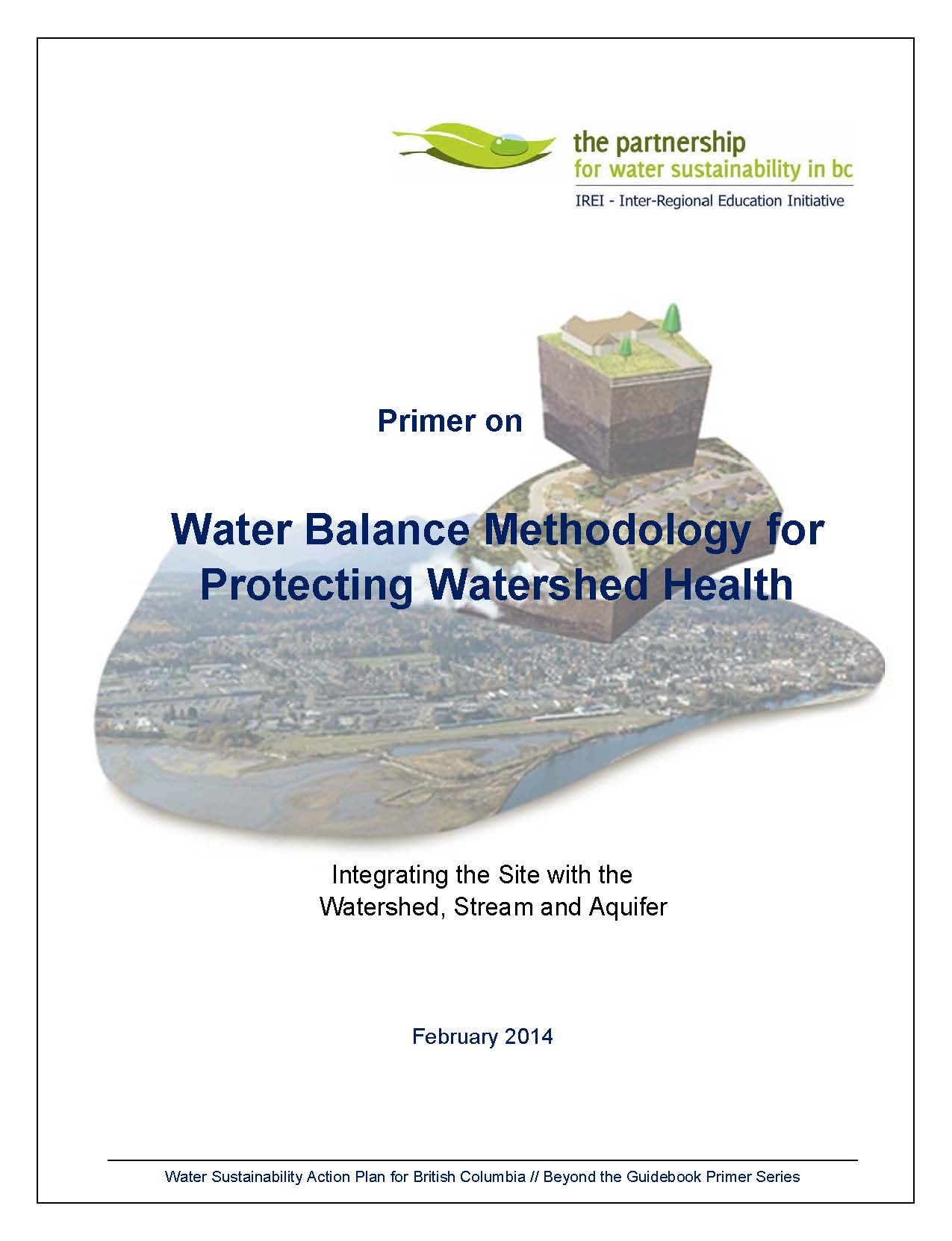GUIDANCE DOCUMENT: Primer on Water Balance Methodology for Protecting Watershed Health
Note to Reader:
The Primer on Water Balance Methodology for Protecting Watershed Health is the fifth in a series of guidance documents released by the Partnership for Water Sustainability in British Columbia since November 2011. Core concepts presented in these companion documents provide an educational foundation for rainwater management in a watershed context.
The Partnership’s purpose in developing the Primers is to inform and educate infrastructure, land use and environmental professionals about implementing actions at the site scale that will achieve desired outcomes at the watershed scale.
These guidance documents form the basis for knowledge-transfer via the Georgia Basin Inter-Regional Education Initiative (IREI). The foundation document for the series is Stormwater Planning: A Guidebook for British Columbia, released in 2002.
Beyond the Guidebook Primer Series
The five guidance documents released to date in the Beyond the Guidebook Primer Series add depth to Stormwater Guidebook. Core concepts presented in the Series provide an educational foundation for rainwater management in a watershed context.
 “The fifth in the Series describes the science-based Water Balance Methodology that integrates engineering and biophysical understanding so that communities can implement Watershed-based Targets that ‘mimic the Natural Water Balance’ and thereby restore and/or protect Watershed Health after the Natural Environment is altered by human activities,” states Kim Stephens, Executive Director of the Partnership for Water Sustainability.
“The fifth in the Series describes the science-based Water Balance Methodology that integrates engineering and biophysical understanding so that communities can implement Watershed-based Targets that ‘mimic the Natural Water Balance’ and thereby restore and/or protect Watershed Health after the Natural Environment is altered by human activities,” states Kim Stephens, Executive Director of the Partnership for Water Sustainability.
“It is helpful to take a step back and view the Water Balance Methodology in an historical context. The methodology is a pragmatic outcome of a ‘design with nature’ guiding philosophy that had its genesis more than two decades ago when British Columbia and Canada co-published the Stewardship Series.”
Historical Context for Water Balance Methodology
“Released circa 1993, Stream Stewardship: A Guide for Planners and Developers document was an early, and in some respects the first, local government focussed design with nature guide,” recalls Erik Karlsen, formerly an Executive Director in the BC Ministry of Municipal Affairs.

Erik Karlsen co-authored a guidance document titled A Watershed / Landscape-Based Approach to Community Planning, released in 2002. Produced by a Metro Vancouver interdisciplinary working group, the underpinning premise is that resource, land use and community design decisions will be made with an eye towards their potential impact on the watershed.
“Not surprisingly, the Stream Stewardship Series was led by a group of landscape architects. Prior to this, although local government legislation empowered local governments to address the topics in this guide, until its publication there was limited guidance available to help planners, developers and biologists to work to together.”
“Looking back over the past 20-plus years, if the Stewardship Series was the first wave, the work of UBC’s James Taylor Chair on Sustainable Urban Landscapes was the second, and the Water Balance Approach is the third.”
“Each of these ‘waves’ was initiated by different ‘groups’ focussing on different aspects of stream stewardship issues; but over time they shared members, and merged from one to the other,” concludes Erik Karlsen.
 “The Water Balance Methodology provides a logical and straightforward way to assess potential impacts resulting from urban development; and analytically demonstrate the effectiveness of the methods proposed for preventing and/or mitigating those impacts,” explains Jim Dumont, the Partnership’s Engineering Applications Authority and principal author of the Primer.
“The Water Balance Methodology provides a logical and straightforward way to assess potential impacts resulting from urban development; and analytically demonstrate the effectiveness of the methods proposed for preventing and/or mitigating those impacts,” explains Jim Dumont, the Partnership’s Engineering Applications Authority and principal author of the Primer.
To Learn More:
To download a copy, click on Primer on Water Balance Methodology for Protecting Watershed Health. The Primer storyline is structured in five parts:
- Part A: Watershed-Based Approach to Rainwater Management
- Part B: Water Balance Methodology Explained
- Part C: Science Behind the Methodology
- Part D: How to Establish Targets
- Part E: References
For a synopsis of each part, click on the following link to Table 1. Information is presented in a layered fashion to accommodate the interests of a continuum of audiences.



